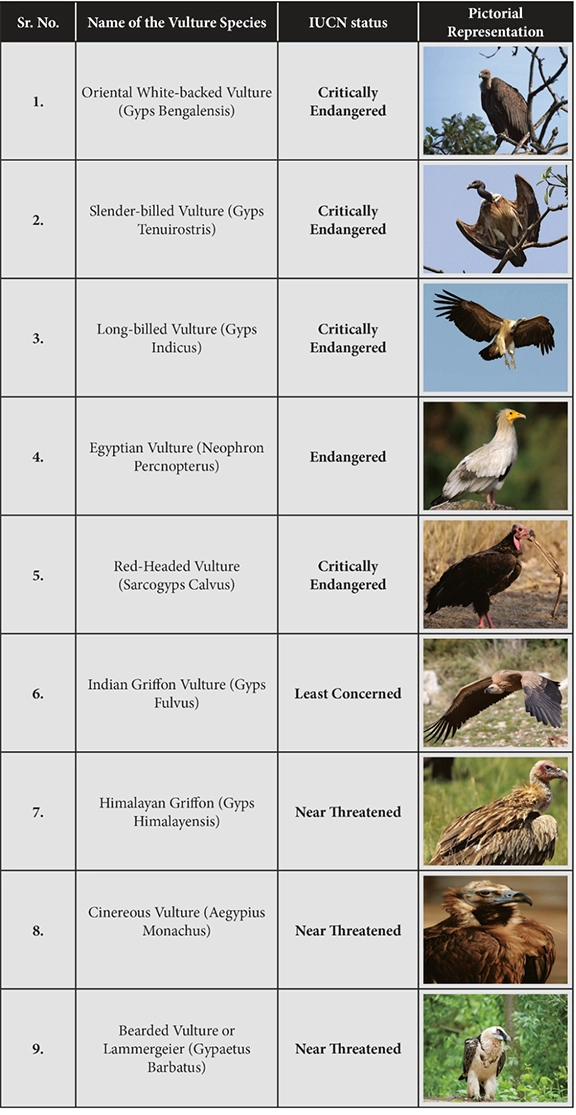Important Facts For Prelims
Conserving Vultures
- 10 Oct 2022
- 4 min read
Why in News?
According to a recent study, vultures mostly forage outside Protected Areas (PAs) and if threats such as poison-laced carcasses are removed from these places, the decline in vulture populations can be stemmed.
What are the Findings of the Report?
- About:
- Vultures avoided areas with high livestock density when feeding, which suggests that vultures did not use cattle as a main food source and avoided areas with high human habitation.
- The finding of the study regarding cattle not being the main food source of vultures did not hold true for India.
- The drastic crash in vulture populations in India was due to the use of diclofenac in veterinary treatment, mainly on cattle. So clearly, vultures fed on livestock.
- Suggestions for Conservation:
- Understanding their habitat use, and even more importantly their behaviour while in certain habitats, like outside of protected areas, is thus critical for their conservation.
- It is vital to identify and remove threats near nesting and roosting sites, and to provide them with food and water.
What about the Vultures Species in India?
- About:
- It is one of the 22 species of large carrion-eating birds that live predominantly in the tropics and subtropics.
- They act an important function as nature’s garbage collectors and help to keep the environment clean of waste.
- Vultures also play a valuable role in keeping wildlife diseases in check.
- India is home to 9 species of Vulture namely the Oriental white-backed, Long-billed, Slender-billed, Himalayan, Red-headed, Egyptian, Bearded, Cinereous and the Eurasian Griffon.
- Most of these 9 species face dangers of extinction.
- Bearded, Long-billed, Slender-billed, Oriental white-backed are protected in the Schedule-1 of the Wildlife Protection Act 1972. Rest are protected under ‘Schedule IV’.
- Most of these 9 species face dangers of extinction.
- International Union for Conservation of Nature (IUCN):
- Threats:
- Poisoning from diclofenac that is used as a medicine for livestock.
- Loss of Natural Habitats due to anthropogenic activities.
- Food Dearth and Contaminated Food.
- Electrocution by Power lines.
- Conservation Efforts:
- Recently, the Ministry for Environment, Forests and Climate Change launched a Vulture Action Plan 2020-25 for the conservation of vultures in the country.
- It will ensure minimum use of Diclofenac and prevent the poisoning of the principal food of vultures, the cattle carcasses.
- To study the cause of deaths of vultures in India, a Vulture Care Centre (VCC) was set up at Pinjore, Haryana in 2001.
- Later in 2004, the VCC was upgraded to being the first Vulture Conservation and Breeding Centre (VCBC) in India.
- At present, there are nine Vulture Conservation and Breeding Centres (VCBC) in India, of which three are directly administered by the Bombay Natural History Society (BNHS).
- Recently, the Ministry for Environment, Forests and Climate Change launched a Vulture Action Plan 2020-25 for the conservation of vultures in the country.
UPSC Civil Services Examination Previous Year Question (PYQ)
Q. Vultures which used to be very common in Indian countryside some years ago are rarely seen nowadays. This is attributed to (2012)
(a) the destruction of their nesting sites by new invasive species
(b) a drug used by cattle owners for treating their diseased cattle
(c) scarcity of food available to them
(d) a widespread, persistent and fatal disease among them.
Ans: (b)







